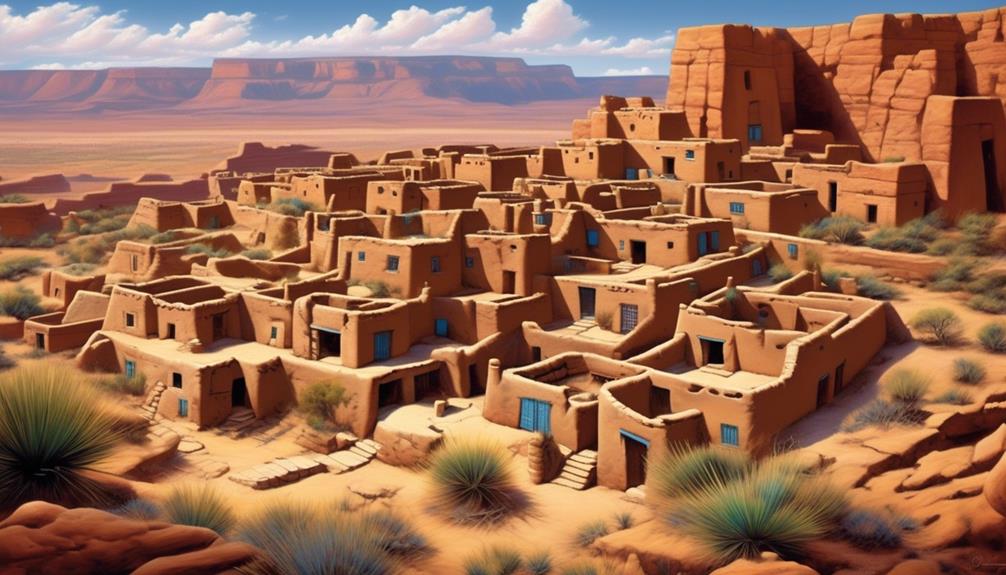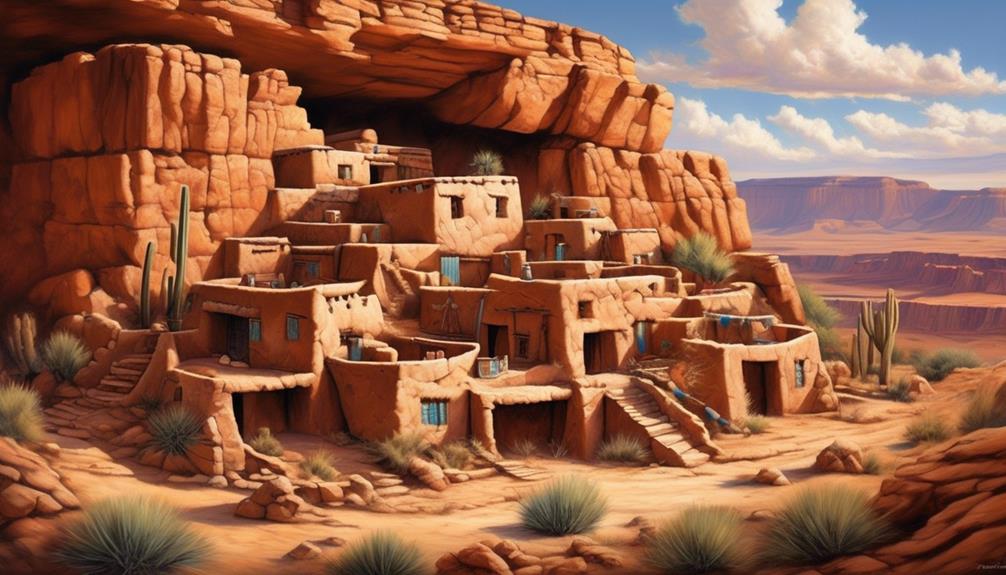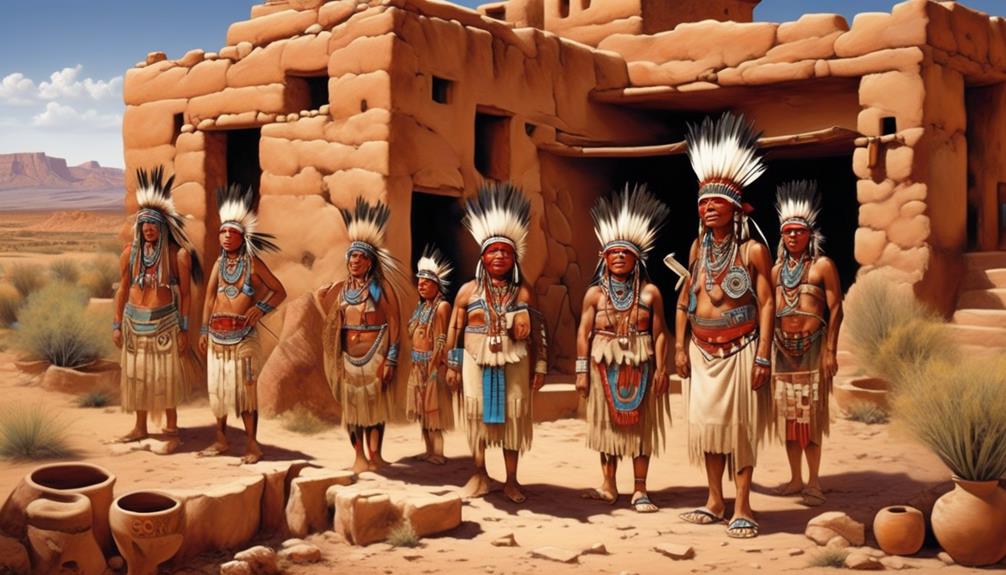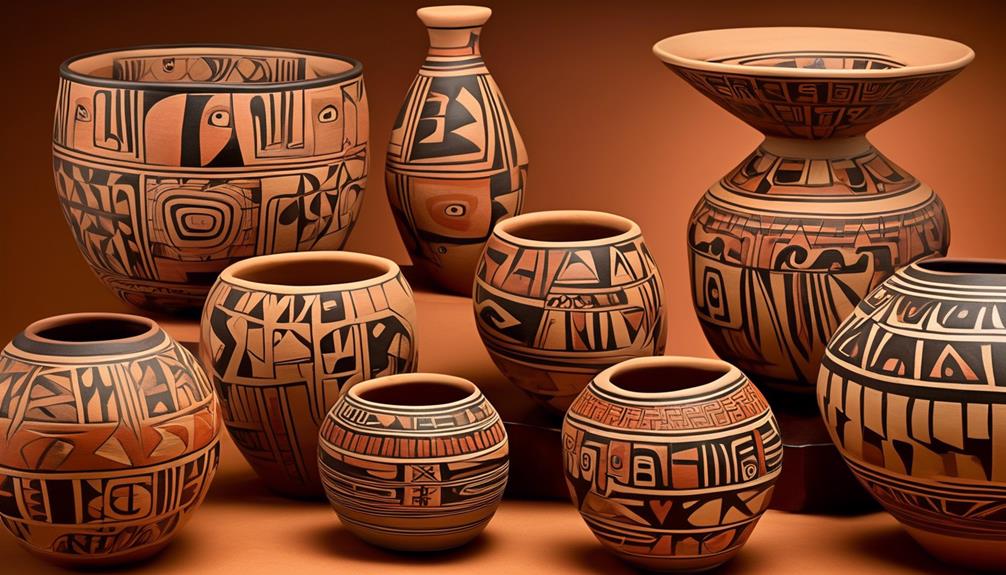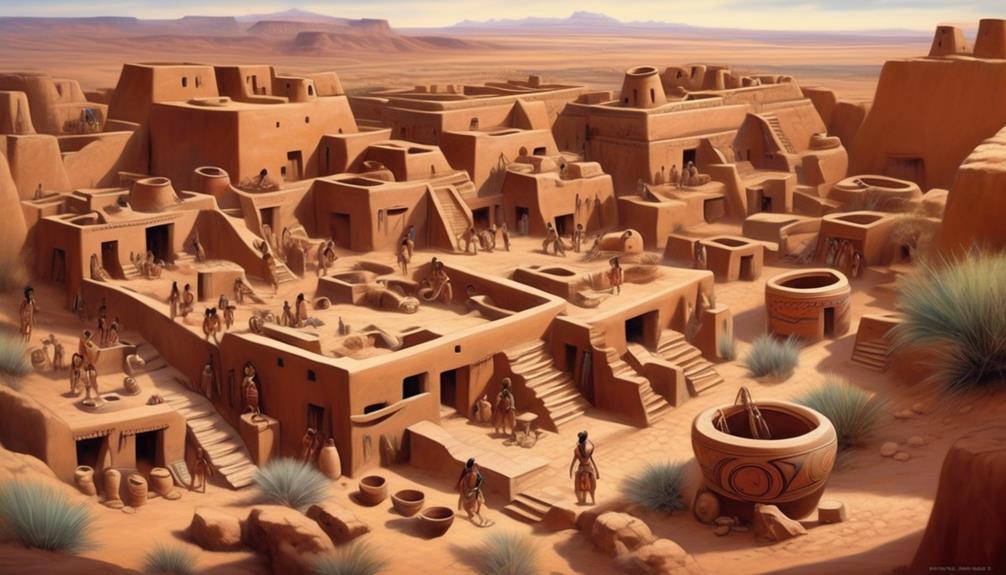Some people may assume that the Hopi tribe only lived in the well-known adobe pueblos, but in reality, their traditional dwellings showcased a variety of architectural designs that complemented their environment.
The intricate connection between their dwellings and agricultural practices is a testament to their deep understanding of sustainability and harmony with nature.
However, there is much more to the way of life of the Hopi tribe that often goes unexplored.
From their spiritual beliefs and ceremonies to the intricate social structure and the impact of modern influences, the way the Hopi tribe lived is a complex tapestry that continues to intrigue and inspire.
Key Takeaways
- Hopi pueblos are ancient multi-story structures made of stone and adobe, reflecting the tribe's respect for the environment.
- Terrace farming and crop rotation are key agricultural practices that ensure food security and preserve the land.
- Hopi spiritual beliefs emphasize maintaining a harmonious relationship with the Earth and utilize sacred spaces for ceremonies tied to the agricultural cycle.
- The Hopi tribe's social structure is based on kinship ties, with villages organized around extended family units and governance based on consensus-building and collective decision-making.
Hopi Traditional Dwellings
The Hopi traditional dwellings, known as 'pueblos,' are ancient multi-story structures made of stone and adobe that have been inhabited for centuries. The use of adobe architecture in constructing these pueblos reflects the Hopi tribe's deep understanding of sustainable living.
The adobe bricks, made from a mixture of clay, sand, straw, and water, provide excellent insulation, keeping the interior cool in the scorching desert heat and warm during chilly nights. This sustainable building material helps maintain a comfortable living environment while reducing the need for excessive energy consumption.
Compared to modern construction methods, the adobe architecture of the Hopi pueblos showcases a remarkable example of sustainable design and living. The natural materials used in the construction of these dwellings not only blend harmoniously with the surrounding landscape but also demonstrate the Hopi people's profound respect for the environment.
Living in these adobe structures has enabled the Hopi tribe to thrive in harmony with nature for generations. The sustainable principles underlying the design and construction of the pueblos continue to inspire contemporary sustainable architecture, emphasizing the importance of living in balance with the earth.
Agricultural Practices
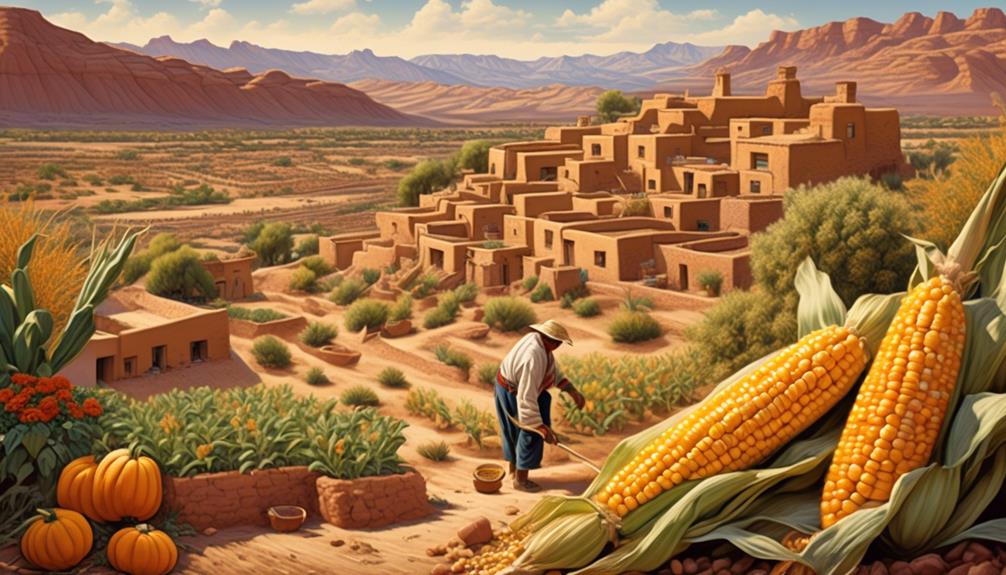
Incorporating sustainable principles similar to those observed in the construction of their traditional dwellings, the Hopi tribe's agricultural practices exemplify a deep connection to the land and a profound understanding of sustainable living.
Terrace farming, a method used by the Hopi tribe, involves creating step-like levels on the hillsides to plant crops. This technique not only prevents soil erosion but also maximizes the use of water in the arid environment where the tribe resides.
Crop rotation is another crucial aspect of the Hopi agricultural tradition. By rotating their crops among different fields, the Hopi people maintain soil fertility and prevent the depletion of nutrients. This practice also helps in controlling pests and diseases, leading to healthier and more sustainable crop yields.
The Hopi tribe's agricultural practices, characterized by terrace farming and crop rotation, showcase their innovative and sustainable approach to food production. These methods not only ensure the tribe's food security but also contribute to the preservation of the land for future generations.
Spiritual Beliefs and Ceremonies
Rooted in their profound connection to the natural world, the Hopi tribe's spiritual beliefs and ceremonies are an integral part of their cultural heritage, guiding their daily lives and interactions with the environment.
The Hopi people believe in the importance of maintaining a harmonious relationship with the Earth and the spiritual forces that govern it. Central to their spiritual practices are shamanic rituals, where shamans act as intermediaries between the physical and spiritual realms, performing healing ceremonies and seeking guidance from the ancestors.
These rituals are conducted in sacred spaces, such as kivas, underground chambers used for spiritual gatherings and ceremonies. The Hopi also engage in sacred ceremonies tied to the agricultural cycle, offering prayers and performing rituals to ensure bountiful harvests and express gratitude to the Earth for its abundance.
These ceremonies serve as a way for the community to come together, reaffirming their connection to the land and the spiritual forces that sustain life.
Community Life and Social Structure
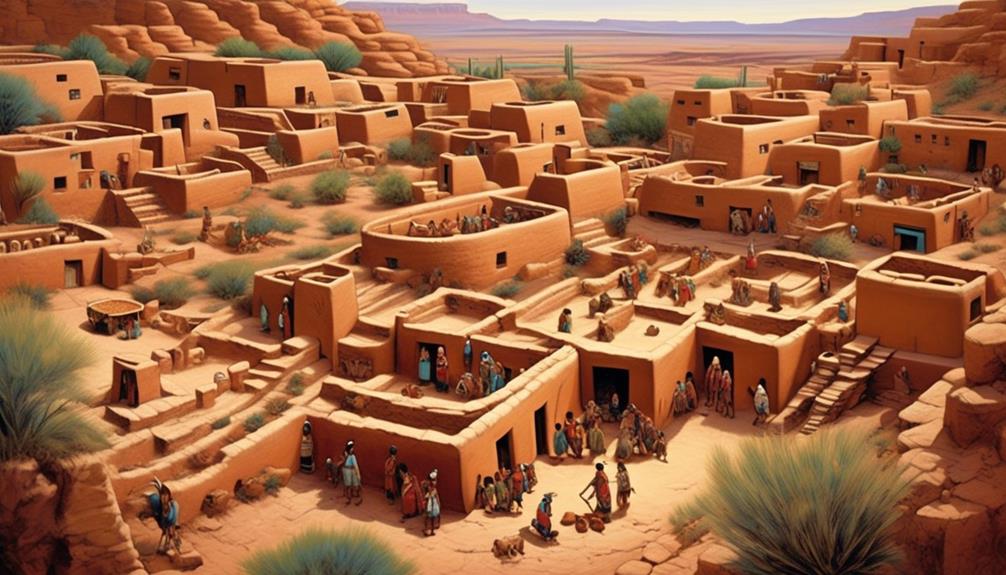
Embedded within the fabric of our spiritual beliefs and ceremonies, our community life and social structure reflect the interconnectedness and solidarity that define the Hopi tribe.
Our tribe's social structure is deeply rooted in kinship ties, where familial relationships form the basis of our community. Our villages are organized around extended family units, and the bonds between relatives are central to our social cohesion.
Additionally, tribal governance plays a crucial role in maintaining our community life. Our governance system is based on consensus-building and collective decision-making, ensuring that every member has a voice in matters that affect the community. This fosters a sense of shared responsibility and unity among the members of our tribe.
Furthermore, our community life is characterized by a strong sense of communal support and cooperation. We come together to celebrate traditions, work on communal projects, and support one another in times of need, creating a tightly-knit social fabric that sustains our way of life.
Impact of Modern Influences
Modern influences have started to reshape certain aspects of our community life and social structure, bringing both opportunities and challenges to our traditional way of living. The introduction of modern technology, education, and economic opportunities has led to lifestyle changes within the Hopi Tribe. With improved access to information and resources, our community has experienced a shift in traditional occupations and a growing participation in the mainstream economy. This has brought economic benefits but also poses the risk of cultural dilution. The younger generation is increasingly exposed to external influences, leading to a shift in values and priorities.
As modern influences continue to permeate our community, there's a growing need to balance the preservation of our cultural heritage with the adoption of beneficial aspects of modernity. Efforts to maintain traditional practices and knowledge are being prioritized to ensure the cultural preservation of our tribe. At the same time, we're actively engaging with modern tools and resources to adapt and thrive in a rapidly changing world. It's a delicate balance, and we're navigating this transition with a deep sense of responsibility towards our heritage and identity.
Frequently Asked Questions
What Are the Traditional Gender Roles Within the Hopi Tribe?
Traditional gender roles within the Hopi tribe are deeply ingrained in societal norms and cultural practices. Men typically engage in agricultural activities and ceremonial duties, while women are responsible for maintaining the household and crafting pottery.
However, both genders play crucial roles in family dynamics and decision-making processes. The division of labor is seen as complementary, with each gender contributing to the overall well-being of the community.
How Do Hopi Tribe Members Choose Their Leaders?
Hopi tribe members choose their leaders through a unique process of tribal decision making. Leadership selection involves a combination of traditional practices and contemporary influences. Candidates demonstrate their knowledge of Hopi customs, exhibit leadership qualities, and gain consensus through community discussions.
The process is inclusive, emphasizing the importance of collective decision making and the preservation of cultural values. This approach to leadership selection reflects the tribe's commitment to upholding its traditions while adapting to modern contexts.
What Are Some Traditional Hopi Games and Pastimes?
Traditionally, Hopi games and pastimes are vital cultural activities.
The Hopi people engage in various traditional games such as foot racing, hoop rolling, and stick races, reflecting their connection to the land and their ancestors.
These activities aren't only recreational but also serve as a way to pass down cultural knowledge and values.
Through these games, the Hopi tribe continues to preserve and celebrate their rich heritage and history.
How Do the Hopi Tribe Members Pass Down Their Oral History and Traditions?
We pass down our oral history and traditions through the art of oral storytelling. This plays a vital role in our cultural preservation. Elders share wisdom and knowledge with the younger generations, ensuring that our traditions are upheld and our history is remembered.
Through storytelling, our values, traditions, and experiences are passed on. This creates a strong sense of identity and connection to our ancestors.
What Is the Role of Art and Craftsmanship in Hopi Culture?
Artistic expression is integral to Hopi culture, serving as a means of cultural preservation.
Through intricate pottery, colorful textiles, and mesmerizing kachina dolls, our traditions and beliefs are vividly depicted.
These artistic creations not only beautify our surroundings but also convey our stories, history, and spiritual connections.
They're a living testament to our identity, enabling us to pass down our heritage to future generations and ensure the continuity of our rich cultural legacy.
Conclusion
In conclusion, the Hopi tribe lived in traditional dwellings and practiced agricultural techniques that sustained their community for generations.
Their spiritual beliefs and ceremonies were central to their way of life, and their strong community and social structure supported their values and traditions.
However, modern influences have had an impact on their way of life, bringing both challenges and opportunities for the Hopi people.
Their resilience and adaptability continue to shape their unique cultural identity.
